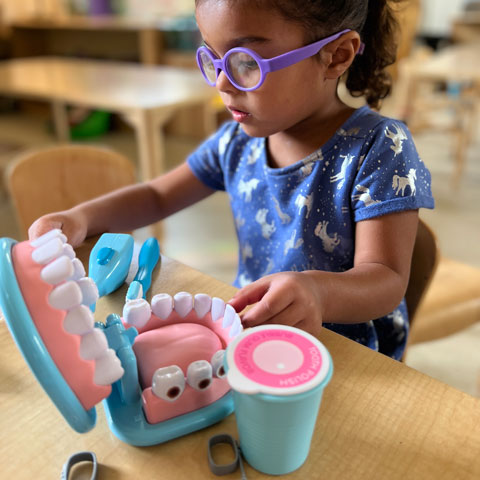Danielle Lobell and Maddie Vega
St. George’s Episcopal School
New Orleans, LA
Fall 2022
The Teeth Project took place at St. George’s Episcopal School, which is an independent school in New Orleans that serves children ages birth through eighth grade. Fourteen students ages 3 through 5 participated in the project. Students in the class receive many supports, including speech and language therapy, occupational therapy, and one-on-one support.
Phase 1: Beginning the Project
In early September, Viola, age 3, went for her dental appointment and was excited to tell the class about it when she returned to school. The rest of the children had so much to say about their experiences, and we could feel the excitement and energy in the air. A few days later, we decided to assess whether dental work and dentistry would be a good topic for a project. Mrs. Maddie brought in her dental X-rays to share with the children at circle time, and we used their prior knowledge to make a group web with them.
We found that everyone had at least some prior knowledge about teeth or the dentist. So next we brought in some secondary sources to start provoking questions. For example, we know that young children think through play, so we asked Ms. Sidney, the speech-language pathologist (SLP), to let us borrow the model of a mouth she uses to model speech sounds.
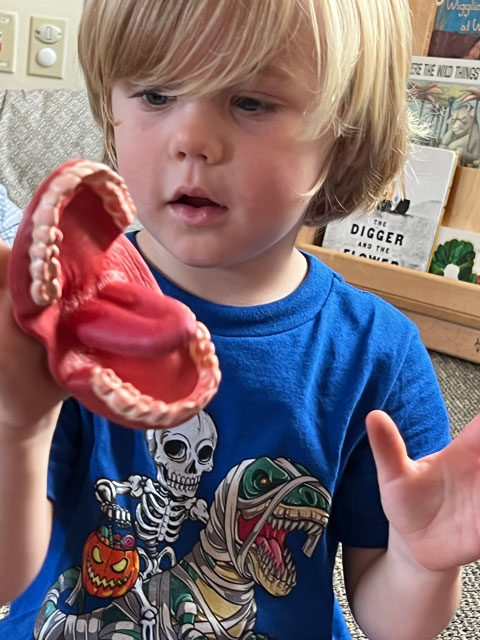
The children’s questions began when we explored tooth brushing, and the children wondered why we brush our teeth. Other beginning questions included: When you eat something hard does it break your teeth? Is soda healthy for your teeth? Why do teeth die? Why do teeth fall out when you grow up?
Phase 2: Developing the Project
To help the children answer their questions about tooth brushing, we brushed vampire teeth covered in germs (brown paint) with toothbrushes and toothpaste (shaving cream). The children noticed how long it took to properly clean teeth.
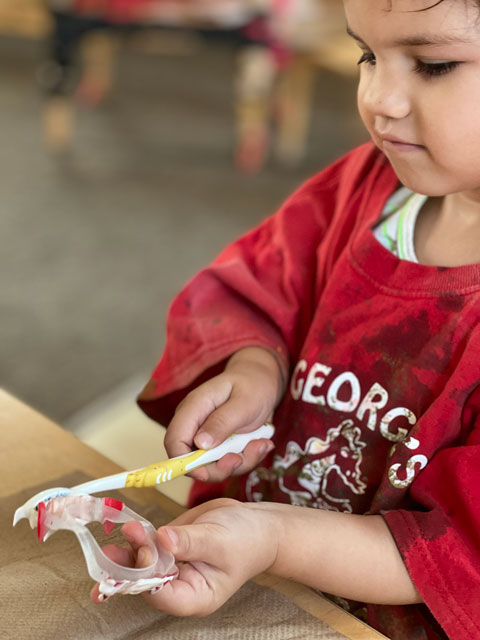
We planned several activities that helped the children explore dental care more deeply. For example, we used ice cube trays that represented our teeth with Play-Doh stuck in the spaces to represent plaque buildup on our teeth. We used real floss and toothbrushes to get out all the plaque so the teeth would be clean.
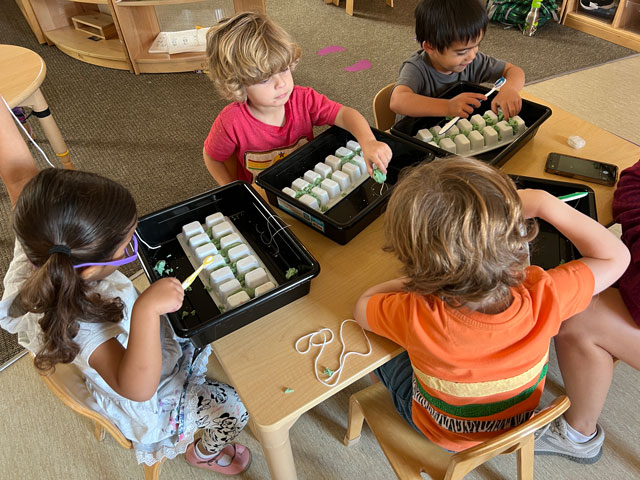
We also explored new dental tools using the Melissa and Doug dentist set and made connections with new vocabulary such as drill, mirror, mouthwash/rinse, and cavities!

The children explored dental bags that were donated by a local dentist’s office. They discovered that the bags contained toothbrushes, floss, and timers. We then taught the children how to use mirrors to help guide us when learning the correct way to floss and brush our teeth.
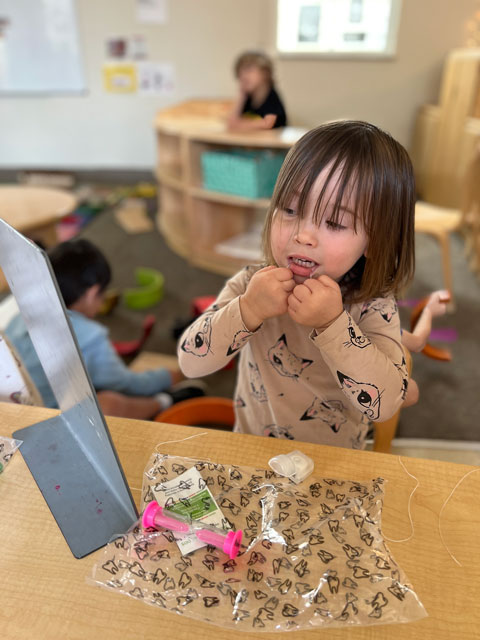
One of the children’s questions was “Is soda healthy for your teeth?” To help them answer this question, we did an experiment using eggs, soda, and water. They learned that the white shell coating on an egg is very similar to the enamel on our teeth. We then took two eggs and put one inside a glass of water and the other inside a glass full of soda.
The children voted on which one they thought would be more damaging to the egg and, therefore, unhealthy for their teeth. After both eggs sat in their jars for 24 hours, the children discovered that soda is unhealthy for teeth and will leave stains on tooth enamel.
We find that hands-on play is a great way to get young children comfortable with things that might be associated with a potentially uncomfortable experience, like brushing their teeth. For example, the children from the Magnolia class loved learning how to brush their teeth and use dental floss properly. In fact, several children asked for dental floss for Christmas.
Dental Experts
Once the children started to learn more about the background of dentistry and how to use dental supplies correctly, we invited guest speakers into the classroom to help expand our knowledge and answer any additional questions.
We added to our web in small groups to collect some ideas about whom to invite. We then invited:
- Ms. Kennedi, who taught us all about her braces! She taught us why people have braces, how braces are put on, and how long people have to wear them. She even brought us some of her X-rays and teeth that had been pulled by her dentist!
- Elle, the big sister of one of our students, Vienna. Elle visited us in the Magnolia room and told us about how you lose your teeth! She brought her tooth box to our class to show everyone where she stores the teeth that she loses.
- Ms. Del, the infant teacher, who visited our room and even brought a teething baby, Hank, with her. She taught us that baby teeth are called “milk” teeth and explained how they grow and at what age they begin to grow in babies.
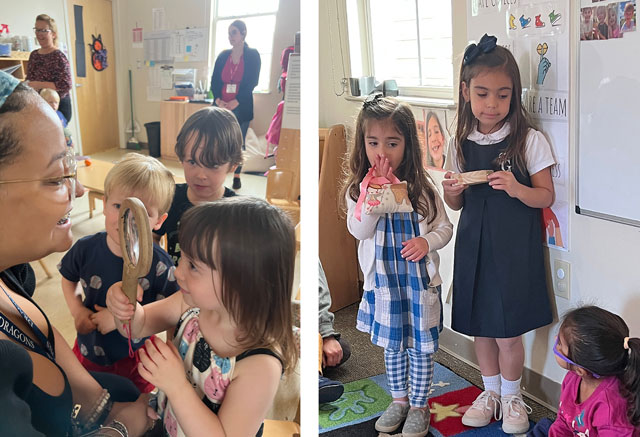
All of our students have connections and experiences with dentists, teeth, and dental stories, so they took turns sharing their “Tooth Stories.” Midway through the Teeth Project, Frankie visited the dentist for a checkup. His mom took pictures and sent them to the teachers. Frankie used the pictures to recall things that happened while he was at the dentist. He told us “you get to lay down on a bed thing. Then the dentist looked at my teeth. They brushed my teeth, and I got to pick what kind of toothpaste I liked.” He was so proud to talk about his experience during his “tooth story” share.
Dr. Alexis Shelton, a pediatric dental surgeon, visited our classroom. She read us a book called Sugarbug Doug (2009) and taught the children all about the importance of brushing your teeth twice a day. She also taught them about gum disease and explained why they should floss their teeth to prevent future gum disease. She brought real authentic materials and even talked us through how to fill a cavity.
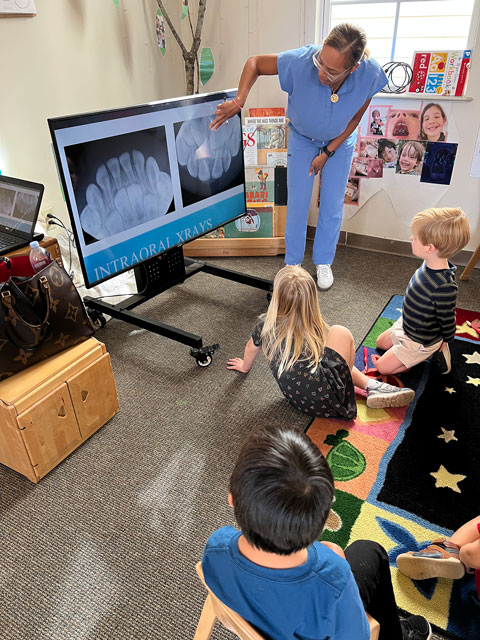
We also had a tooth hunt! The students each had a chance to walk around the ECC building and ask different teachers and students if they could look at their teeth. They used iPod touches to take pictures and had clipboards with paper and pencil to make observational drawings of how the other child’s teeth looked to them. This hunt was a great strategy for teaching them how to gather data.
Field Site Visits
For our field site trip, we visited Avenue Dentistry! The dentists presented the children with procedures that typically happen during a dental visit. For example, they went into a real dental exam room and got to sit in the dental chair.
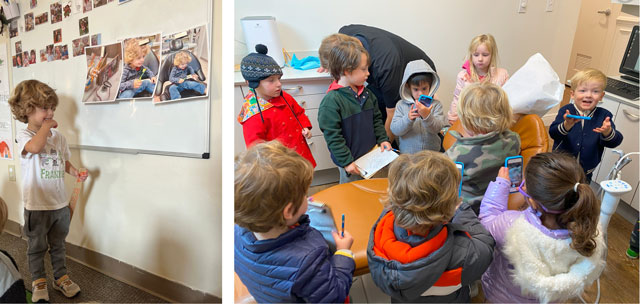
They showed them all of the tools they use, the children got to feel them. The dentists encouraged each child to try sitting in the dental chair, and they even read the children a dental story. The children brought their clipboards with pencils and paper as well as iPod Touches with them so they could document what they noticed at the dentist’s office.
Phase 3: Concluding the Project
For our culminating event, the children from the Magnolia room decided to make a dental project movie. This was a child-led movie where the children signed up for roles (e.g., dentist, dental assistant, light and sound, patient, and set design). The children came up with their story plot and acted it out. We revealed their finished movie during our Christmas party, and the children got to show their families all of their hard work.
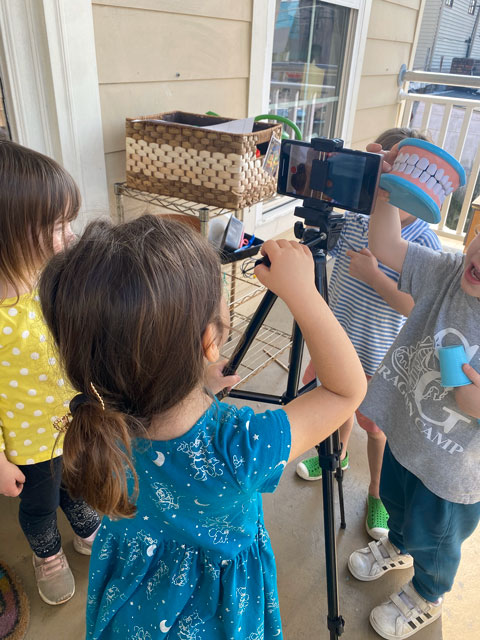
Teacher Reflection
We learned just as much as the children did about teeth and dental hygiene. We both came in with relatively little prior knowledge (and a little bit of fear!) as adults. Working through the children’s theories and misconceptions with them revealed so much about their unique perspectives and how they process the world around them.
Because we started this project early in the year, the project provided us with insight into how the children express themselves. For example, we noticed how they engaged with authentic materials and play. Some students expressed their wonderings verbally, others through pretend, while others were more focused on real tools and supplies. We were able to use this knowledge to connect with the children and understand them in a way we might not have otherwise.
We were both surprised by how interested the students were in this topic and how sustained their interest was. The project lasted almost four months with high engagement and momentum. This was likely such a good topic because students had meaningful prior knowledge and experiences, there were plenty of authentic materials and hands-on ways for them to learn more, their practice of important skills came about naturally, and there were many different subtopics to explore. We also had many opportunities for experts and field site visits.
We were not sure if the children would be able to recall all the technical terms and purposes of the dental tools. Not only did they remember, but they absolutely delighted our neighborhood dentist with their knowledge during our site visit.
It was really meaningful for us to see how happy and proud the children were to educate the community about what they had learned. On a personal note, it actually helped both teachers as well as the students be more confident about future visits to the dentist.
We had quite a few students who were a little reserved at the start of the year and didn’t always want to participate in circle time or large group activities. This project gave them opportunities to express themselves in a variety of ways and allowed them to have the creative freedom they needed to be heard. This project was such a great experience, and our students still talk about it.


